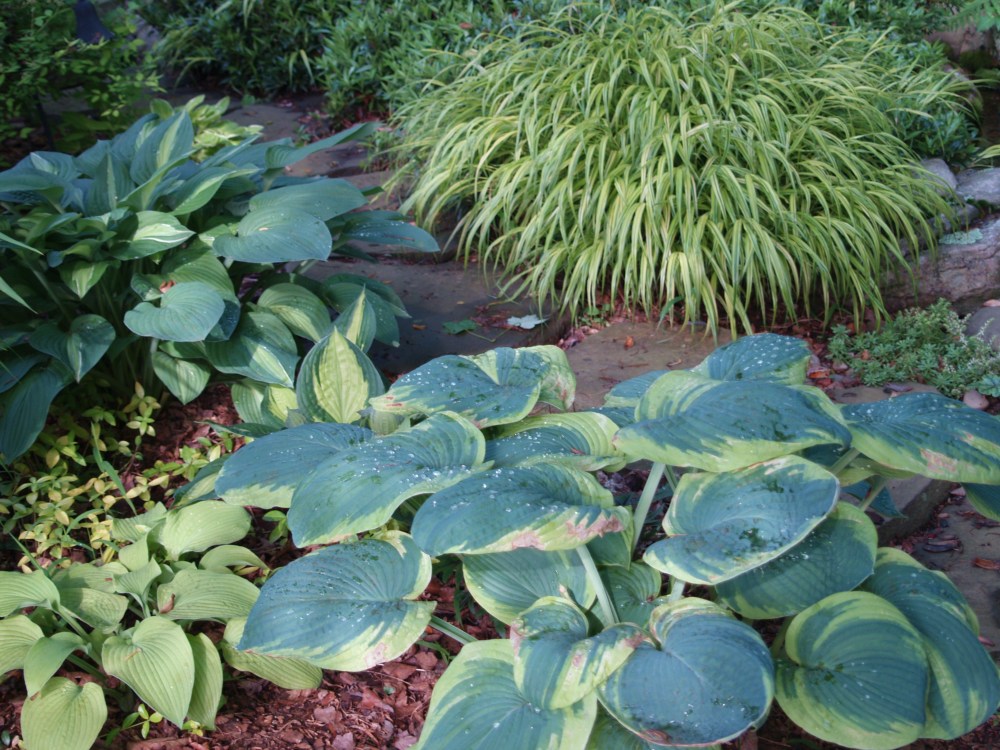An abundance of hosta seedlings annually pop up in the garden, and while many must be removed because they grow immediately at the edge of a path, others are left in place and encouraged. In two years the clumps grow fat and full, and the leaves large so that my faulty memory presumes they’ve been there all along and I must have paid a dear price for them.
The leaves for most of these are similar; large, slightly blue-green, and heavily corrugated, much like the old favorite Siebold elegans. I’ve bought several similar hostas, though I can’t recall now which ones I bought and which ones are volunteers. And it hardly matters.
Occasionally, one of the variegated hostas reverts to the same blue-green or plain green, though the vigorous invader that crowds out the old clump could be just another seedling. I’m certain that a more attentive gardener would chop the encroaching hosta out before it overwhelms the more prized variegated clump, but for one reason or another I let them go for a year (or two), and one day the damage is done and the all that remains is the large leafed blue-green hosta.
One seedling hosta grows on a small island between two small waterfalls in the middle of one of the garden ponds. At one time only a few stones and river gravel covered the rubber pond liner, then moss began to grow, and then the hosta appeared. At first, I couldn’t imagine that the hosta would survive with so little soil, but its roots have snaked under and around the small rocks and into the shallows of the pond, and the clump is multiplying and obviously enjoying this spot. Now, one waterfall is completely obscured, but I’ve grown fond of this seedling, and it will stay as long as it pleases.
Not all seedlings are blue or green, or even attractive. One odd looking seedling with narrow, ribbed, almost yellow foliage popped up five or six years ago between a clump of daisies and Japanese Forest grass. There is nothing noteworthy about this almost ugly hosta, except that it is almost ugly in a way that no other hosta in the garden is. So, I’ve carefully kept a space carved out for it. Certainly not one of my proudest moments, but I noticed a few days ago that it looks better this spring, much better, to the point it could almost be possible to believe it came from the garden center. But not quite.
At one time there were more than a hundred varieties of hosta in the garden, but I ignored the damage that deer were inflicting for a few too many years, and a dozen or more disappeared. Now, I spray a deer repellent at the start of each month May through October. Several hostas that had declined considerably have returned to good health, and the deer don’t bother them at all (unless I skip over a plant when I’m spraying). Occasionally, there is some damage to hostas from slugs, and hail in summer thunderstorms can inflict damage on hostas without tree cover, but these injuries are usually minor.
This spring I’ve planted a handful of new hostas, divided a few of the oldest clumps, and transplanted a few of the more robust seedlings to more permanent homes. I’ve always felt that it’s not possible to have too many hostas. Differing foliage sizes and colors blend readily, and so long as one doesn’t shade the other they will live in harmony for many years. Generally, I favor large leafed types, which I’m supposing is very typical of a man’s garden, but there are a sprinkling of cute, small leafed hostas, some that have have spread to cover a good bit of ground.
Most of the hostas are planted in medium to heavy shade, though a few have most of a full day’s sun. A few hostas struggle along in root infested dry shade, but even here they perform better than other shade tolerant plants. In slightly damp or deeper soils the hostas thrive, and the clumps become fat and the leaves large. Though they require almost no care at all, if the gardener makes any effort to keep out deer and invading seedlings the hosta is likely to survive at least as long as the gardener.
I think your mystery hosta looks great, and not only men like giant hostas–they’re my favorites too. I am “de-grassifying” my front yard and have added several varieties of hosta, among other things. Some of them are mysteries as well, not because they are volunteers, but because I forgot what I bought or divided many years ago or, in some cases, recently. 🙂
I get quite a lot of volunteer plants, but no hostas! On the other hand, we don’t have deer either! Worst pests here are woodpigeons!
My garden has no woodpigeons, but in the past several months vultures have begun to hang out high in the trees above the garden. I hope I’m not looking that bad that they’re waiting to pick my bones.
I can’t be certain because I’ve gotten into a good routine spraying the deer repellent, but the large blue leafed hostas have never been bothered by deer, and most of the seedling hostas appear to be this type. Most of the seedlings pop up in areas that are slightly damp and shady. In those same areas I’m now fighting millions of swamp red maple seedlings, so I have to weed with some caution if any of the hostas are to be grown on.